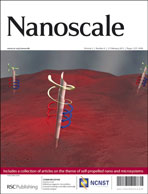Here we describe the first example of using self-propelled antibody-functionalized synthetic catalytic microengines for capturing and transporting target proteins between the different reservoirs of a lab-on-a-chip (LOC) device. A new catalytic polymer/Ni/Pt microtube engine, containing carboxy moieties on its mixed poly(3,4-ethylenedioxythiophene) (PEDOT)/COOH–PEDOT polymeric outermost layer, is further functionalized with the antibody receptor to selectively recognize and capture the target protein. The new motor-based microchip immunoassay operations are carried out without any bulk fluid flow, replacing the common washing steps in antibody-based protein bioassays with the active transport of the captured protein throughout the different reservoirs, where each step of the immunoassay takes place. A first microchip format involving an ‘on-the-fly’ double-antibody sandwich assay (DASA) is used for demonstrating the selective capture of the target protein, in the presence of excess of non-target proteins. A secondary antibody tagged with a polymeric-sphere tracer allows the direct visualization of the binding events. In a second approach the immuno-nanomotor captures and transports the microsphere-tagged antigen through a microchannel network. An anti-protein-A modified microengine is finally used to demonstrate the selective capture, transport and convenient label-free optical detection of a Staphylococcus aureus target bacteria (containing proteinA in its cell wall) in the presence of a large excess of non-target (Saccharomyces cerevisiae) cells. The resulting nanomotor-based microchip immunoassay offers considerable potential for diverse applications in clinical diagnostics, environmental and security monitoring fields.

You have access to this article
 Please wait while we load your content...
Something went wrong. Try again?
Please wait while we load your content...
Something went wrong. Try again?


 Please wait while we load your content...
Please wait while we load your content...